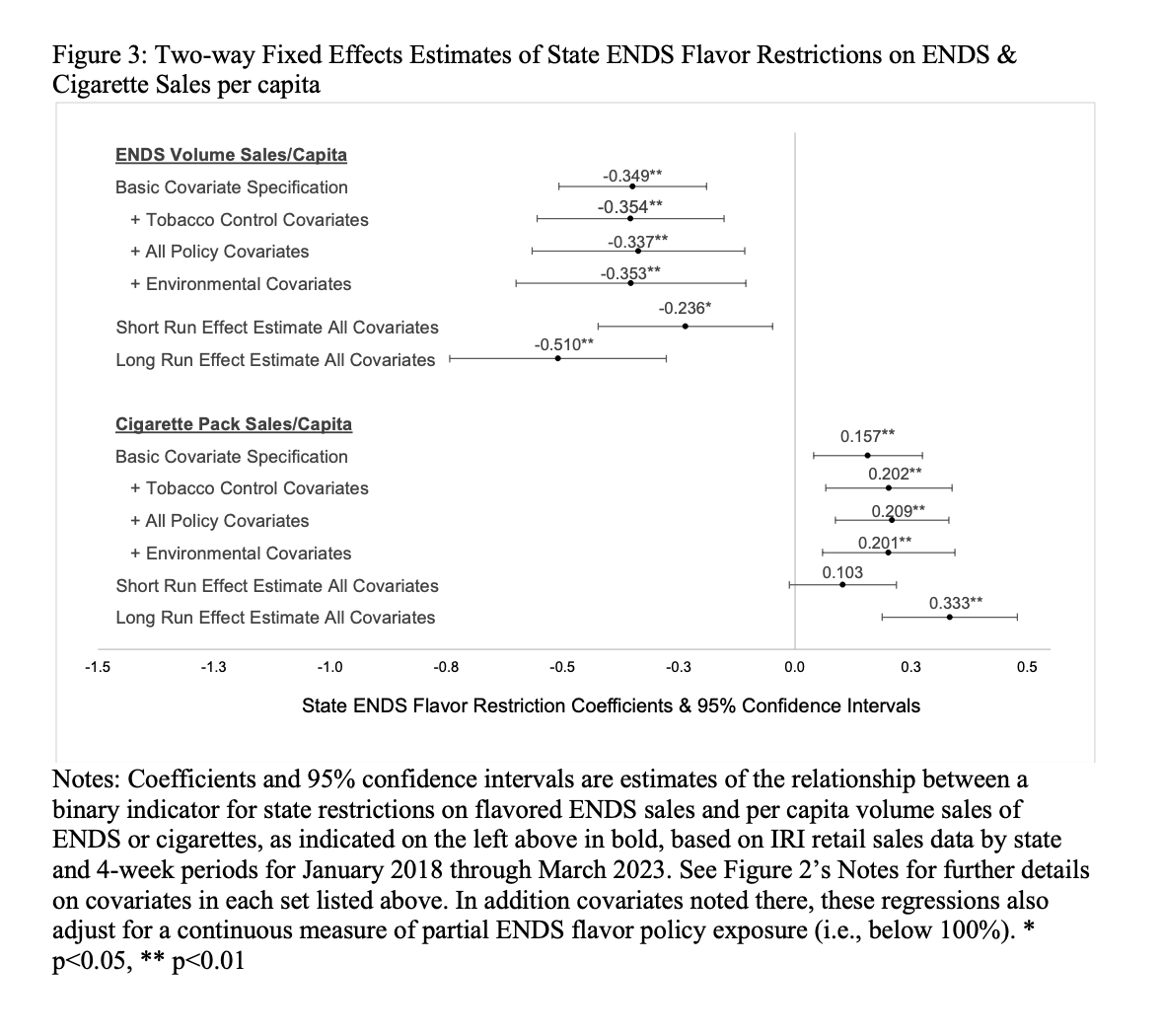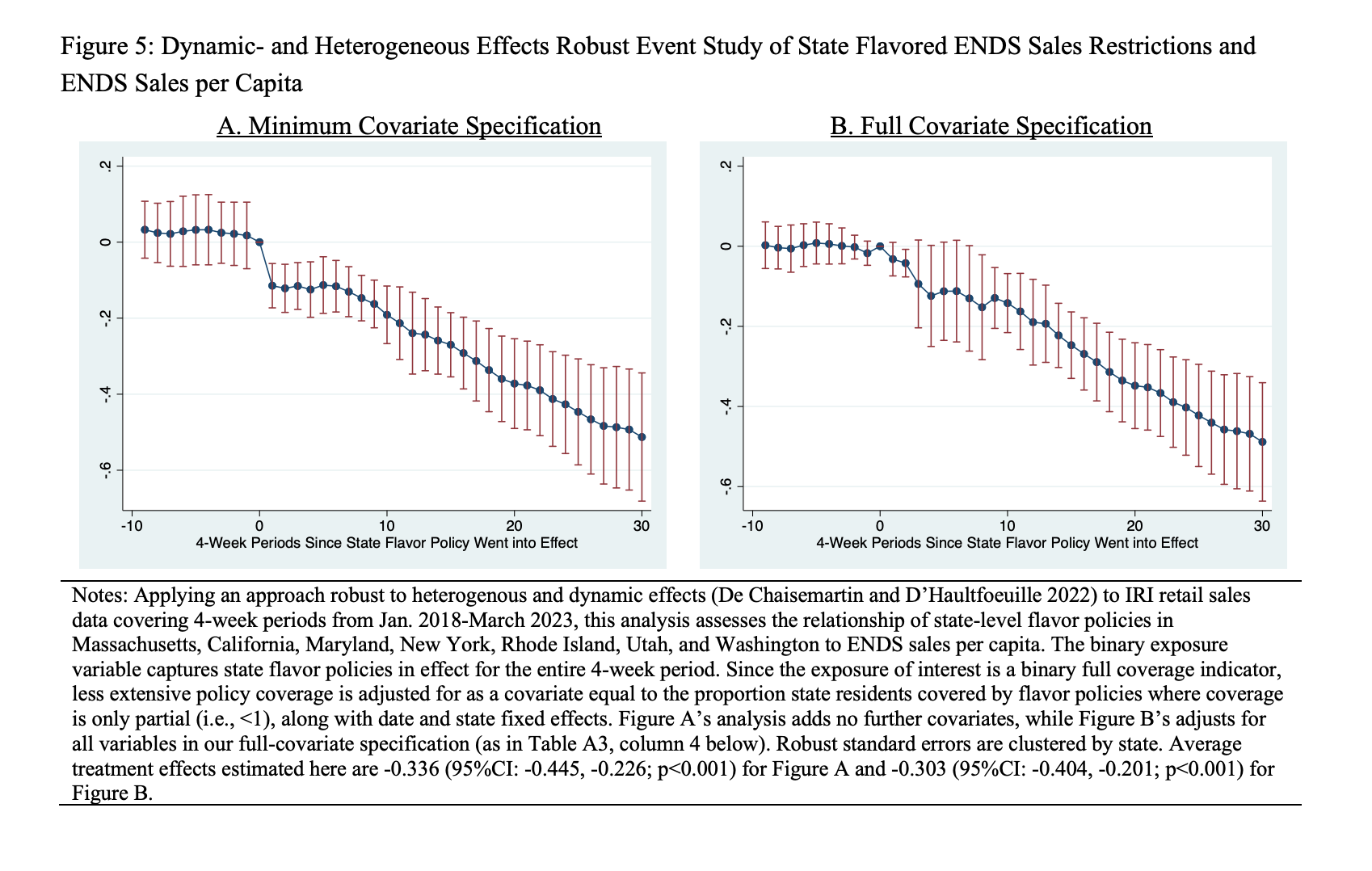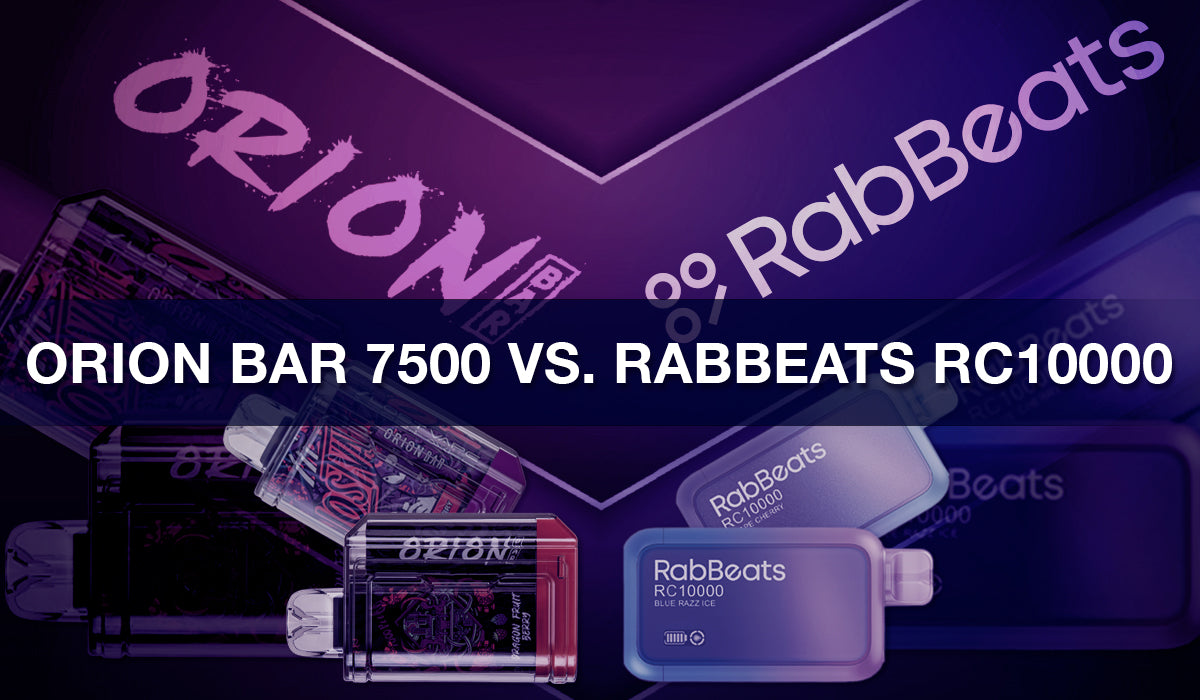
FDA Study Shows Vape Flavor Bans Increase Cigarette Sales
New research funded by the FDA and National Institute of Health (NIH) found that restrictions on nicotine vape flavors result in a corresponding increase in cigarette sales and decrease in the sale of Electronic Nicotine Delivery Systems (ENDS). This finding serves as a stark reminder about the impact poorly considered vape flavor bans can have on public health.
The term ENDS and flavored ENDS in this study refers to prefilled pods, disposables, and e-liquids.
While tobacco vapes are created by adding an artificial tobacco A 'characterizing' flavor is defined as a 'clearly noticeable smell or taste other than one of tobacco.
E-Cigarette Flavor Bans Boost Cigarette Sales
The study, titled E-Cigarette Flavor Restrictions’ Effects on Tobacco Product Sales, was conducted by Yale University’s Abigail Friedman, Georgetown’s Alex Liber and Michael Pesko of the University of Missouri.
The study’s authors concluded that any potential health benefits obtained by flavor restrictions are more than offset by the increased sale of combustible cigarettes.
Five Key Findings of Study
The authors of the study linking vape flavor bans to increased cigarette sales broke their research into five key findings:
- Electronic Nicotine Delivery System (ENDS) sales fall and cigarette sales rise at a greater rate when a higher percentage of state residents is subject to flavor bans. These effects are consistent with product substitution.
- For vape flavor bans in effect for a year or longer, the corresponding decline in ENDS sales and subsequent increase in cigarette sales increases with time.
- Tobacco-flavored cigarettes, as opposed to menthol cigarettes, make up 71 percent of the increased cigarette sales associated with ENDS flavor restrictions.
- The link between ENDS flavor restrictions and increased cigarette sales holds across cigarette product age profiles, including brands used disproportionately by underage youth.
- Restricting ENDS sales to particular types of retailers, i.e., age-restricted vape shops, still results in reductions in ENDS sales and increased cigarette sales once these restrictions are in place for at least one year.
Analysis of Study Findings
What sticks out most about the study tying flavor bans to a rise in cigarette sales is how predictable the results are.
“Our findings linking ENDS flavor restrictions to an additional 15 cigarettes sold for every 1 less 0.7mL ENDS pod sold suggest increased cigarette sales could partly or more than fully offset any public health benefit of reducing ENDS use by restricting or prohibiting flavors.”
Put in pre-Federal Flavor Ban terms, for each 4-pack of Juul Mint no longer sold, there are now 3 packs of cigarettes sold in its place. As data collection started in 2018, it is natural that the once popular and now banned line of flavored and prefilled Juul pods would loom large in the study.
Key Finding #1: The fall of vape sales and rise of cigarette sales is faster in areas with widespread flavor bans.
In the first key finding, the authors discovered that the drop in vape sales and increase in cigarette sales is greater in areas where flavor bans are widespread. If there is no near-by border to cross in order obtain flavored vapes, then vape sales will plunge and cigarette sales will spike more quickly.
Key Finding #2: The decline in vape sales and rise in cigarette sales increases the longer a flavor ban is in place.
The second key takeaway is grim. As time elapses, flavor bans not only result in fewer smokers switching to vaping, but the number of vapers funneled back onto combustible cigarettes increases.
This is the most salient issue from the entire study. It has been five years since Doctor Farsalino’s comprehensive study on flavored vapes was submitted to the FDA. His research has since been verified by other researchers.
He found that the longer adults vape the more likely they are to switch from vapes flavored with tobacco flavors to vapes with “characterizing” flavors that mimic fruit, beverages, and confections. The prevalence of the vilified confection and fruit flavored vape juices is a market driven phenomena and that market is adult vapers. It is no mystery why artificial fruit and dessert flavors are preferred to equally artificial faux-tobacco flavors that lobbyists have deemed acceptable.
Key Finding #3: Tobacco flavored cigarettes, as opposed to menthol, make up 71 percent of the cigarette sales increase linked to vape flavor bans.
The authors did a good job of covering bases with their third key point.
"This finding indicates that the observed substitution response to ENDS flavor policies cannot be attributed to menthol cigarettes’ availability nor fully counteracted by menthol cigarette sales prohibitions."
Menthol cigarettes are almost as big of a lightning rod as vape flavors and are banned in many areas. Yet regular cigarettes make 71 percent of the increase in sales linked to vape flavor bans.
This finding severs any effort to link the decline in vape sales from flavor bans and to the continued availability of menthol cigarettes. Menthol cigarettes make up 37 percent of all cigarette sales according to the CDC but only 29 percent of the cigarette sales increase attributed to flavor bans.
Naturally, areas that ban vape flavors are also more likely to also ban menthol cigarettes and explains this significant discrepancy in marketshare. But it was important to cut that spurious link off at the pass.
Key Finding #4: The link between vape sales declining after flavor bans as cigarette sales increase holds true across all age and demographic groups.
The true bankruptcy of US flavor restrictions is laid exposed by their fourth point. No matter the age profile or brand, denying access to flavored vapes will funnel vapes onto cigarettes.
Key Finding #5: Allowing flavored vape sales at vape shops and age-restricted stores does not prevent a drop in flavored vape sales and increase in cigarette sales after restrictions are in place one year.
What is interesting is how the fifth key finding was that limiting flavored vapes to specific stores still increased the sale of cigarettes. This is no doubt music to the tobacco industry’s ears as it demonstrates that brick and mortar vape shops simply do not have a wide-enough footprint to compete with convenience stores.
Likely the hobbyists frequenting vape shops are less likely switch back, and cigarettes presumably would not be available at a vape shop in any event. The flip side is that c-store buyers of disposable vapes and flavored pods would be particularly vulnerable to be funneled back onto the cigarettes that dominate the shelf space behind the counter should further restrictions be enacted.
Health Impact of Vape Flavor Bans
The dangers of flavor bans funneling vapers back onto cigarettes should be self-evident, and is hard to believe in 2023 that we are still in the position of having to argue the about vaping and cigarettes. Anti-vaping tropes like popcorn lung, kid-friendly marketing, and a debunked heart attack study are like zombies that refuse to die.
The EVALI lung disease from the fall of 2019 was linked to black market cannabis cartridges and the ingredient at fault (vitamin E acetate) was not found in a single commercially available nicotine vape. Vitamin E acetate is an oil and incompatible with the standard vape juice formula of vegetable glycerin and propylene glycol.
But a lot of money has been spent to muddy the water. Cigarettes are the leading cause of preventable death in the US and claim 480,000 lives annually according to the CDC. Smoking on average slices 10 years off of life expectancy.
Vaping Heart Attack Study Retracted
With Doctor Stanton Glantz's incredibly flawed study linking heart attacks and vaping retracted and similar efforts under scrutiny, as reported in the USA Today, almost all credible research has found vaping to be preferable to smoking.
Even enemies of vaping such as former FDA commissioner Scott Gottlieb freely concede this point. The UK goes further with their website: Vaping to Quit Smoking.
Here is a King's College London Study, which found: "The use of vaping products rather than smoking leads to a substantial reduction in exposure to toxicants that promote cancer, lung disease and cardiovascular disease."
Economic Impact of Vape of Flavor Bans
This study can be considered a harbinger of what is to come in terms of health outcomes for adults addicted to nicotine. But as the harshest of vape flavor restrictions are only a few years old, the full impact will not be felt for a decade.
Sufficient time has elapsed to bankrupt thousands of mom and pop vape businesses. A national vape flavor ban would close the book on 100,000 full-time jobs and eviscerate an industry responsible for $16 billion in economic activity, according to a definitive white paper submitted to the Supreme Court on behalf of the Vaping Technology Association.
Big Tobacco and Bloomberg-funded anti-vaping lobbyists are dictating public health policy with aggressive lobbying and marketing campaigns. A carnival of unnecessary death, illness and economic suffering are sure to follow unless more humane and science-based vaping policies are embraced.
Vape Policy Failures
The patchwork of US policies on vaping and flavors is the opposite of the UK’s humane embrace of harm reduction. Their National Health Service hosts a website titled “Using E-Cigarettes to Stop Smoking”.
The FDA’s policy, as demonstrated by their own research, has the opposite effect. They might as well create a website named: Using Vape Flavor Bans to Increase Smoking, because that is the current result of their regulatory expertise.
Whether that was the initial intent or not, this is the outcome and this case of politics and lobbyist money trumping science and human lives will further erode public trust in our political system.
Big Tobacco Supports Vape Flavor Bans
No one should be surprised that Big Tobacco, especially RJ Reynolds, is a major proponent of additional restrictions on vape flavors. They have the legal firepower to navigate FDA regulations, but ideally would prefer to sell their more profitable cigarettes rather than their outmoded collection of obsolete cig-a-likes and expensive to operate pod kits.
A typical disposable vape has five to ten-times the e-liquid capacity of a Vuse Alto pod, and superior coil and battery technology as well. Disposables vapes are also still available in the characterizing sweet flavors that adult vapers prefer. These are the very flavors whose prohibition is driving people, humans, fellow citizens, neighbors, and family members, back into the hungry maw of Big Tobacco.
If disposable vape flavors were to be banned in the same manner as prefilled pods and this is the frenzied objective of Big Tobacco and Bloomberg's ecosystem of nicotine abstinence advocates, more cigarettes will be sold. Period. And the FDA's own numbers prove it.
Big Tobacco's Motivations
Big Tobacco has a lot of skin in the game. Whether it is ethical or not, we live in a capitalist society and they answer to their shareholders. Their endgame is to remove competition to their combustibles by banning the most popular vaping products and to use their bottomless resources to successfully navigate the Byzantine vaping regulations. Currently, the only PMTA approved products are from Big Tobacco, tobacco flavored, and woefully obsolescent.
Bloomberg Philanthropies
As demonstrated in the vape flavor ban and cigarette sales study, the policies promoted by Bloomberg funded nicotine prohibitionists and Astroturf mouthpieces like the Orwellian-named Truth Initiative will have a calamitous impact on public health and have already helped the bottom line profits of Big Tobacco by killing off the competition.
In theory, they want total nicotine abstinence and should abhor the tobacco industry more than Cuttwood for making an e-liquid named Unicorn Milk that was purchased by adult hobbyists.
Not even the most conspiratorial minded person could think they have any interest in propping up cigarette sales or promoting the premature death of vapers.
The term "useful idiots" is falsely attributed to Vladimir Lenin. It describes people who are manipulated by devious and ruthless sources into propagandizing for a bad cause. If the shoe fits...
Philippines Takes Back their FDA Vape Policy From Bloomberg
The bottomless resources of Bloomberg Philanthropies and their web of tobacco control lobbyists have had an enormous impact on vape regulations globally.
The Philippines identified a Bloomberg takeover of their FDA and subsequent vape ban as a form of colonialism rife with conflicts of interest. This takeover has been reversed and their Bloomberg infiltrated FDA stripped of oversight.
Specifically, the Philippine Senate became suspicious of a portfolio stocked with pharmaceutical company shares. After investigations conducted by local harm reduction groups, they found Bloomberg Philanthropies to be invested in Big Pharma companies that manufacture nicotine replacement therapies. These products include patches, gums, and lozenges, all of which have been summarily demolished on multiple occasions when pitted against vaping as a smoking cessation tool.
The most famous of these studies was published in the New England Journal of Medicine Study.
Final Thoughts
In fairness, no similar corruption expose or reckoning has occurred in the US. Frankly, our citizenry seems inured to money and lobbyists calling the shots, and it is doubtful that it would make a whit of difference in terms of public policy if such links were uncovered.
But fact flavor bans are boosting cigarette sales should be more than sufficient reason to revisit myriad failed regulatory policies that have once again ensnared adult vapers in the clutches of the tobacco industry.
The views and opinions expressed in this article are solely those of the author and do not necessarily represent those of any institution or organization that the author may be associated with. This analysis is based on my personal perspective, research and experience, and should not be taken as a reflection of the policies or stance of my employer or any other agency.
Tables and Figures



















Leave a comment
This site is protected by hCaptcha and the hCaptcha Privacy Policy and Terms of Service apply.